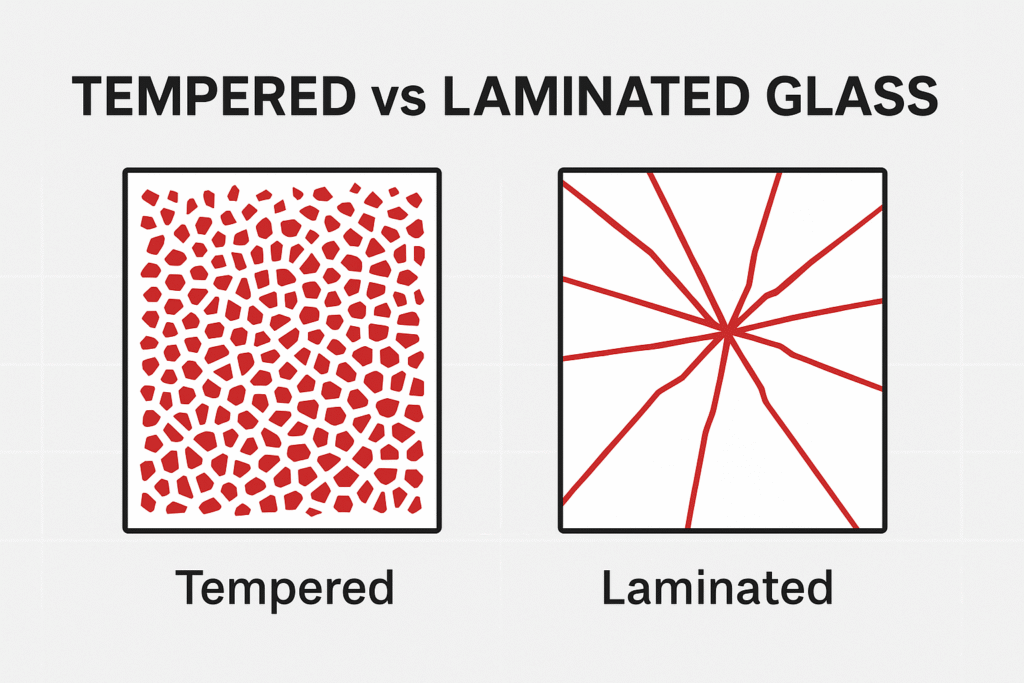
Tempered vs Laminated Glass: Which Safety Glass Do You Need?
Tempered vs Laminated Glass: Which Safety Glass Do You Need?
Both tempered and laminated glass count as “safety glazing,” but they behave differently in real-world use. This guide explains how each type is made, how it breaks, where it’s used, and the standards that prove performance—so you can specify the right option with confidence.
What counts as safety glass?
In the UK, glazing in “critical locations” (doors, side panels near doors, low-level areas, bathrooms, stairs and barriers) must be safety glass or otherwise protected, as set out in Approved Document K. Impact performance is classified by BS EN 12600, while product-specific standards include BS EN 12150 for tempered (toughened) glass and BS EN 14449 for laminated glass.
Tempered (Toughened) Glass — strength & “granular” breakage
How it’s made: standard float glass is heated and rapidly cooled, creating surface compression that makes it several times stronger than annealed glass of the same thickness.
How it breaks: when failure occurs, tempered glass disintegrates into many small, relatively blunt granules—reducing the risk of laceration. This characteristic is part of the impact safety classification under BS EN 12600.
Typical uses
- Shower screens and bath enclosures
- Doors and side panels near doors
- Low-level glazing (below 800 mm)
- Furniture tops, shelves and protectors
For buying options and specs, see the tempered glass page.
Advantages
- High strength for its thickness; cost-effective and widely available
- Safer break pattern (small granules)
- Short lead times in common thicknesses (6–10 mm)
Limitations
- Once tempered, it cannot be cut or processed further
- Post-breakage there is no residual barrier—granules fall away
- Can be sensitive to edge damage or hard impacts at fixings
Laminated Glass — layered safety & post-breakage containment
How it’s made: two or more glass sheets are bonded with a polymer interlayer (e.g., PVB, EVA, or ionoplast). The interlayer holds fragments in place if the glass cracks, maintaining a barrier.
How it breaks: you’ll see crack patterns, but pieces adhere to the interlayer—this is crucial where falling hazards exist or where glass overhead must remain intact until replaced. Laminated safety glass is covered by BS EN 14449 and classified to BS EN 12600.
Typical uses
- Balustrades and guarding (often combined with toughening)
- Overhead glazing and canopies
- Shopfronts and security-oriented façade work
- Acoustic or UV-filtering requirements (special interlayers)
Advantages
- Remains in place after breakage, preserving a barrier
- Accepts specialty interlayers (acoustic, stiff ionoplast, tinted)
- Often preferred by designers for frameless balustrades
Limitations
- Heavier and generally more expensive than single-ply tempered
- Edges and interlayer need careful detailing to avoid moisture ingress
- Longer lead times in custom make-ups
Quick comparison
| Property | Tempered (toughened) | Laminated |
|---|---|---|
| Standards | BS EN 12150 • Classified to BS EN 12600 | BS EN 14449 • Classified to BS EN 12600 |
| Break behaviour | Disintegrates into small granules | Cracks but fragments adhere to interlayer |
| Post-breakage safety | No residual barrier | Remains in place, maintains guarding |
| Typical thickness for interiors | 6–10 mm common | Two plies (e.g., 8.8, 10.8, 12.8 mm etc.) |
| Best for | Showers, doors, low-level glazing, furniture | Balustrades, overhead glazing, shopfronts, acoustic |
| Cost & lead time | Usually lower cost; fast in stock sizes | Higher cost; made-to-order |
How to choose: three quick scenarios
1) Bathroom & wet areas
Tempered glass is the go-to for shower screens and bath enclosures because it’s strong, economical, and breaks into small granules. Check that the product is marked to BS EN 12150 and classified under BS EN 12600.
2) Balconies, landings & stair guards
Where glass acts as a barrier against falling, laminated glass is typically required so that a broken pane still provides containment. Designs should also meet height and load rules in BS 6180.
3) Furniture & table tops
For freestanding protectors or tops, tempered glass offers strength and a safe break pattern. Thickness depends on size and support; see general guidance in the table above and product details on the tempered glass page.
Handrails & “no-rail” designs
BS 6180 includes cases where a continuous handrail is required for barriers protecting drops, but allows exceptions when laminated toughened glass is used and remains in place after breakage. Always confirm the specific system’s test data and fixing details before choosing a rail-free design.
Care, marks & identification
- Look for permanent stamps / declarations of conformity to the relevant standards.
- Avoid abrasive cleaners; use microfibre cloths and non-ammonia sprays.
- For external laminates, discuss edge detailing and interlayer choice to reduce moisture ingress and maintain clarity over time.
Standards and guidance evolve—always check the current documents and consult Building Control for installations in critical locations.
FAQs
Is laminated glass stronger than tempered glass?
They’re strong in different ways. Tempered glass provides high impact strength for its thickness; laminated glass adds post-breakage containment thanks to the interlayer. For barriers and overhead, laminated (often with toughened plies) is preferred because it stays in place if damaged.
Which one is safer?
Both are “safety glass.” Tempered breaks into small granules; laminated stays intact after cracking. The safer choice depends on location: for fall protection or overhead, laminated is usually specified; for showers and furniture, tempered is common.
Can I cut tempered glass at home?
No. Tempered glass cannot be cut or drilled after toughening. All processing must be done before heat treatment.
Does laminated glass block UV or reduce noise?
Many interlayers filter UV significantly, and acoustic interlayers can reduce sound transmission. Ask for performance data for the specific laminate build-up.
References: Approved Document K • BS EN 12600 • BS EN 12150 • BS EN 14449.
